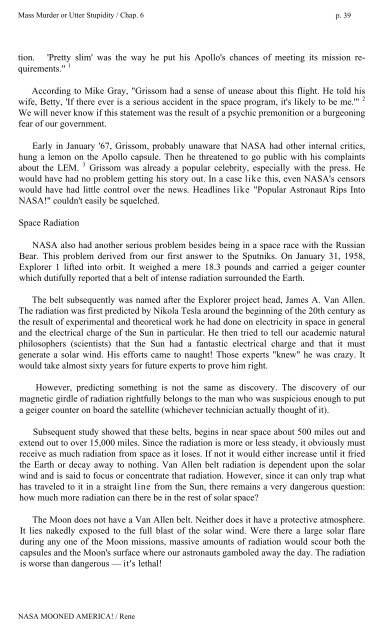Rene-NASA-Mooned-America
Rene-NASA-Mooned-America
Rene-NASA-Mooned-America
You also want an ePaper? Increase the reach of your titles
YUMPU automatically turns print PDFs into web optimized ePapers that Google loves.
Mass Murder or Utter Stupidity / Chap. 6 p. 39<br />
tion. 'Pretty slim' was the way he put his Apollo's chances of meeting its mission requirements."<br />
1<br />
According to Mike Gray, "Grissom had a sense of unease about this flight. He told his<br />
wife, Betty, 'If there ever is a serious accident in the space program, it's likely to be me.'" 2<br />
We will never know if this statement was the result of a psychic premonition or a burgeoning<br />
fear of our government.<br />
Early in January '67, Grissom, probably unaware that <strong>NASA</strong> had other internal critics,<br />
hung a lemon on the Apollo capsule. Then he threatened to go public with his complaints<br />
about the LEM. 3 Grissom was already a popular celebrity, especially with the press. He<br />
would have had no problem getting his story out. In a case like this, even <strong>NASA</strong>'s censors<br />
would have had little control over the news. Headlines like "Popular Astronaut Rips Into<br />
<strong>NASA</strong>!" couldn't easily be squelched.<br />
Space Radiation<br />
<strong>NASA</strong> also had another serious problem besides being in a space race with the Russian<br />
Bear. This problem derived from our first answer to the Sputniks. On January 31, 1958,<br />
Explorer 1 lifted into orbit. It weighed a mere 18.3 pounds and carried a geiger counter<br />
which dutifully reported that a belt of intense radiation surrounded the Earth.<br />
The belt subsequently was named after the Explorer project head, James A. Van Allen.<br />
The radiation was first predicted by Nikola Tesla around the beginning of the 20th century as<br />
the result of experimental and theoretical work he had done on electricity in space in general<br />
and the electrical charge of the Sun in particular. He then tried to tell our academic natural<br />
philosophers (scientists) that the Sun had a fantastic electrical charge and that it must<br />
generate a solar wind. His efforts came to naught! Those experts "knew" he was crazy. It<br />
would take almost sixty years for future experts to prove him right.<br />
However, predicting something is not the same as discovery. The discovery of our<br />
magnetic girdle of radiation rightfully belongs to the man who was suspicious enough to put<br />
a geiger counter on board the satellite (whichever technician actually thought of it).<br />
Subsequent study showed that these belts, begins in near space about 500 miles out and<br />
extend out to over 15,000 miles. Since the radiation is more or less steady, it obviously must<br />
receive as much radiation from space as it loses. If not it would either increase until it fried<br />
the Earth or decay away to nothing. Van Allen belt radiation is dependent upon the solar<br />
wind and is said to focus or concentrate that radiation. However, since it can only trap what<br />
has traveled to it in a straight line from the Sun, there remains a very dangerous question:<br />
how much more radiation can there be in the rest of solar space<br />
The Moon does not have a Van Allen belt. Neither does it have a protective atmosphere.<br />
It lies nakedly exposed to the full blast of the solar wind. Were there a large solar flare<br />
during any one of the Moon missions, massive amounts of radiation would scour both the<br />
capsules and the Moon's surface where our astronauts gamboled away the day. The radiation<br />
is worse than dangerous — it's lethal!<br />
<strong>NASA</strong> MOONED AMERICA! / <strong>Rene</strong>


